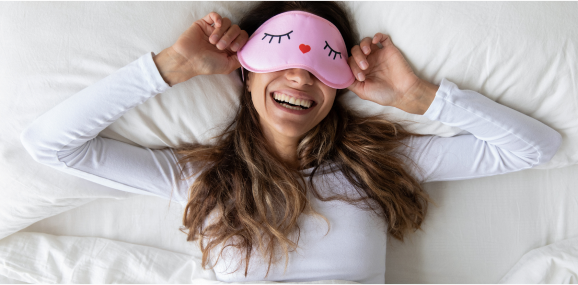Maybe you received one as a gift. Or maybe, after one too many sleepless nights, you did a little digging and discovered that weighted blankets might help calm your mind and relax your body.
Either way, you’re curious about weighted blankets and the looming question they present: Are they going to make me hot when I go to sleep?
It’s a smart question, and the team of sleep pros at Hug Sleep understands the concern.
Your sleep temperature is important. We’ll explain why and cover everything you need to know about how weighted blankets work. We’ll also give you a different solution for staying cool and relaxed when the temperatures rise.
What Happens When It’s Too Hot at Night?
When temperatures soar, your sleep declines. Sleep experts agree that your bedroom should be fairly cool (between 60 and 70 degrees Fahrenheit), quiet, and dark for you to get the best sleep possible. When it’s too hot, it’s harder to get the sleep you need, and the lack of sleep you experience will have an impact on your overall health.
Sleeplessness affects every system and process in our bodies, including our mental health and our ability to function properly on a daily basis. While it can be normal to have a night of poor sleep every now and then, continued poor sleep means that you should consider making some changes to your sleep environment.
Deep, Restorative Sleep
When the temperature rises, you’re unlikely to get as much restorative deep sleep. Your body does the majority of its reparative and restorative work when you sleep, and to get the maximum benefits, you need to be able to successfully cycle through all four phases of sleep.
The four phases of sleep include:
- Awake. This doesn’t refer to your normal daytime hours but rather the time you spend in bed before you fall asleep or during the periods when you wake up in the night.
- Light. Here, your respiration and heart rate slow, your body temperature drops, and your muscles relax and sometimes twitch (which is known as a “hypnagogic jerk”).
- Deep. In this restorative phase of sleep, tissue growth and cellular repair happen everywhere from your muscles to your brain. If you wake up in this phase, you’ll likely feel disoriented and groggy because of your brain’s long, slow waves.
- REM. Finally, you enter the Rapid Eye Movement phase of sleep. In this last stage, your respiration and heart rate increase. You may experience vivid dreams, but your body will generally be immobilized to prevent sleepwalking.
If you aren’t able to get all four cycles of sleep when you rest, your body will miss out on important restoration, leaving you feeling tired and even affecting your immunity. You might end up feeling sick more frequently, or you might feel like you catch every cold that goes around.
Additionally, deep sleep is when our brain has time to package and store thoughts and information from our day. Without deep sleep, brain function declines. Some research suggests that lack of sleep can even increase your risk of developing long-term cognitive diseases like Alzheimer’s and dementia.
Night Sweats
Waking up in a sweat isn’t a very comfortable experience — especially if you need to change your sheets.
If you typically shower before bed, waking up sweaty and in need of another rinse could set you behind schedule and affect your entire day. You’ll be behind schedule and using more water than necessary, which can increase both your carbon footprint and your water bill.
Clearly, temperature matters when you sleep. In fact, it matters so much your body actually takes a step toward cooling you down before you hit the sack.
How Your Body Prepares for Sleep
The human body is amazing in its ability to keep us awake when we need to be awake, and help us sleep when we need rest. There are built-in functions in our bodies that help us determine when we should be awake and when we should be asleep.
- Circadian rhythm. Your circadian rhythm lets your body know when it’s time to get out of bed and when it’s time to wind down. Sometimes referred to as your internal clock, this rhythm is based on daylight exposure and helps make sure we rest in the evenings. (Unfortunately, activities like shift work or jet lag can sometimes interfere with your circadian rhythm.)
- Sleep drive. Your sleep drive is your body’s need for sleep. When you wake up well-rested, your sleep drive is low. As you expend energy throughout the day, your sleep drive increases. By evening, your sleep drive tells your body it’s tired and needs rest.
These two functions do a lot to help you sleep, but getting a good night of rest is a little more complicated.
Body Temperature Changes and Sleep
Before sleep, your core body temperature drops slightly, signaling your body that it is time for sleep and making it easier for you to rest. While your core temp only drops slightly (one to two degrees), it’s enough to give you a chill and send you under the blankets.
Your Nervous System Responds
The nervous system also plays a role in your ability to sleep soundly. Although your awake and sleep times are mostly governed by your circadian rhythm and your sleep drive, there are also two parts of the nervous system that are involved with relaxation and alertness. These two parts both need to function at the right times for you to get sleepy.
Understanding the Nervous System and Sleep
The two parts of your nervous system most involved with helping you sleep (or preventing you from sleeping) are your sympathetic nervous system (SNS) and your parasympathetic nervous system (PSNS).
The Sympathetic Nervous System
The sympathetic nervous system is active during the day. It keeps you alert and aware of what’s going on around you. It’s in charge of your fight or flight response, and it’s also in charge of triggering the release of certain hormones like cortisol.
Feelings of stress, worry, and nervousness all stem from your sympathetic nervous system. These feelings aren’t necessarily bad, since it’s important to be motivated by stress when you have an urgent deadline or need to make a split-second decision. However, too much stress can lead to significant sleep problems.
The Parasympathetic Nervous System
The parasympathetic nervous system is more active in the evenings and overnight. It’s the counterbalance to the sympathetic nervous system. The PSNS slows your heart rate, relaxes your muscles, and triggers the release of hormones like serotonin and dopamine. Your PSNS needs to be engaged to help you ease into rest and prepare your body for sleep.
The problem is that it’s sometimes hard for your nervous system to effectively make the switch. Due to stressful life events, deadlines at work, and increased negative feelings about being able to sleep, your SNS sometimes works a later shift than it should, making it hard for your PSNS to communicate the need to rest to your body.
A solution? Deep touch pressure therapy. Weighted blankets use the science of deep touch pressure therapy to help engage your PSNS and offer your body a chance to relax.
What Are Weighted Blankets?
Weighted blankets are based on the science of deep touch pressure therapy, also known as deep touch pressure stimulation (DTPS). This type of therapy involves the use of gentle pressure applied to the body to stimulate the PSNS.
Weighted blankets are designed with filling that makes them heavier than a typical blanket. By adding weight, they’re able to deliver this type of pressure stimulation to help you relax. Unfortunately, a heavy blanket may not be ideal for delivering this type of sensory experience.
Are Weighted Blankets Hot?
They can be. They can also be uncomfortable. In fact, some people feel restricted or experience feelings of too much pressure using a weighted blanket.
To understand the big picture, let’s look at how these blankets are designed.
Fabric
The fabric used on a weighted blanket will definitely impact whether or not it’s going to make you sweat. The fabric naturally has to be durable enough to support the weight of the materials inside — which can lead to less breathability than a traditional blanket.
Fabrics that are notorious for trapping heat and making you sweat include:
- Wool
- Flannel
- Some heavy cotton blends
- Polyester blends that are tightly woven and not breathable
Sleeping beneath these types of fabrics will likely make even the most cold-natured among us too hot to be comfortable for sleep.
Filling
The filling inside of a weighted blanket can also create heat. Some of the most popular fillings are beads made from polyester, steel, or even a type of glass. While some fillers are designed to allow for better airflow, others really retain heat. This is especially true for polyfill beads.
Natural beads are also an option, with varieties of sand, beans, or rice available. The problem with these fillers is when it comes time to wash the blanket. If these types of blankets are washable, the inside of the fabric is usually lined with some type of protective plastic, making the blanket hotter than one that isn’t lined.
Are Weighted Blankets Comfortable?
Some find the weight of a blanket incredibly comforting. Just how much weight you should use is important, especially for children. Because weighted blankets can be restricting, you never want to use a weighted blanket that is more than 10% of your body weight.
Weighted blankets can also be too restrictive for some people. The heavier the blanket, the more difficult it may be for you to change positions while you sleep, something most of us do between 10-40 times per night.
If you have trouble with sleep but feel like a weighted blanket isn’t the best solution for you, you’ve got options.
The Hug Sleep Sleep Pod
Based on the science of DTPS, the Hug Sleep Sleep Pod offers an innovative way to deliver the stimulation you need to engage your PSNS, but without any added weight.
Our Sleep Pod works like a swaddle, the same thing used to relax infants and help them sleep. It cocoons your body in material that offers gentle, constant pressure, just like a hug. Made with ultra-breathable, four-way stretch polyspan fabric, the Sleep Pod allows for full mobility whether you wear it alone or under your bedding.
By focusing on fabric instead of fill, we’re able to deliver compression without weight. It’s a solution that helps most people relax. And if you’re the type of sleeper who likes their feet to be able to roam free, we’ve got the Sleep Pod Move designed just for you.
Keep Cool Without Being Weighed Down
Keeping your body temperature low while you sleep is important in ensuring you get a good night’s sleep. While the science behind weighted blankets is solid, they can be too hot for proper sleep. A better solution to get the deep touch pressure stimulation your body needs is by using gentle compression.
The Hug Sleep Sleep Pod delivers this deep touch pressure, giving you the ability to snuggle into supreme comfort, relax your mind, and ease your body into rest. You’ll rest better, sleep longer, and enjoy the benefits of a cool, comfortable sleep experience unlike any other.
Sources:
The Relationship Between Insomnia and Body Temperatures | PubMed
What to Do When It's Too Hot to Sleep | Consumer Reports
Sleep & Immunity: Can a Lack of Sleep Make You Sick? | Sleep Foundation
The Temperature Dependence of Sleep | PubMed
Difference Between Sympathetic and Parasympathetic Nervous System | Pediaa.com
How Does Lack of Sleep Affect Cognitive Impairment? |Sleep Foundation

































500,000+ happy customers